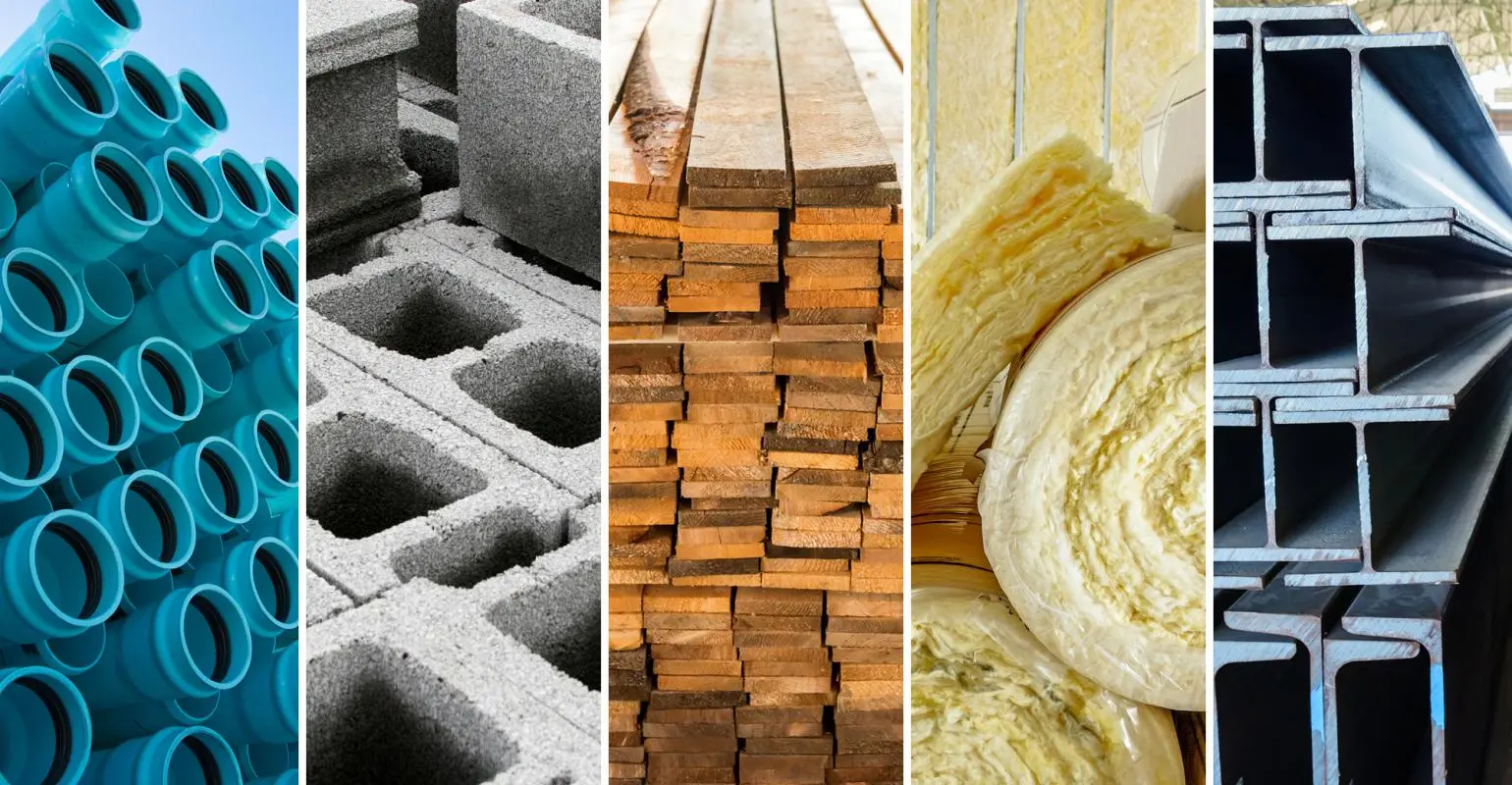Stepping into the world of construction is like entering a realm where imagination takes physical form. At the heart of this transformation lie construction materials, the unsung heroes that shape our homes, workplaces, and cities. From towering skyscrapers to quaint cottages, these materials dictate not just aesthetics, but also a building’s strength, comfort, and resilience against the elements.
This comprehensive guide delves into the intricate world of construction materials, empowering you to make informed decisions for your projects. We’ll explore various material types, their unique properties, and the factors to consider during the selection process.
Understanding the Building Blocks: Types of Construction Materials
Just like a chef carefully selects ingredients for a culinary masterpiece, choosing the right construction materials is crucial for a successful project. Each material brings its own set of characteristics, influencing a structure’s durability, sustainability, and overall aesthetic.
Natural Building Materials: Timeless and Enduring
These materials, sourced directly from nature, have been the backbone of construction for centuries:
- Wood: A renewable resource, wood offers versatility, strength, and natural beauty. From structural framing to decorative finishes, wood remains a popular choice for its aesthetic appeal and sustainability.
- Stone: Known for its durability and resistance to fire, stone has been used in construction since ancient times. It’s an ideal material for foundations, walls, and decorative elements, adding a touch of elegance and permanence to structures.
- Clay: This natural material, found in abundance, is the key component of bricks and blocks. Clay offers excellent insulation properties, regulating temperature naturally while remaining environmentally friendly.
Artificial Building Materials: Modern Solutions for Contemporary Construction
With technological advancements, artificial building materials offer innovative solutions to meet the demands of modern construction:
- Concrete: A mixture of cement, aggregates, and water, concrete is prized for its strength, versatility, and cost-effectiveness. From foundations to walls and floors, concrete forms the skeletal structure of numerous buildings.
- Steel: Renowned for its exceptional strength-to-weight ratio, steel is a staple in large-scale constructions and infrastructure projects. It’s the backbone of skyscrapers, bridges, and other structures requiring immense load-bearing capacity.
- Glass: Beyond its aesthetic appeal, glass plays a vital role in modern architecture, allowing natural light to permeate interiors while providing insulation. From windows and doors to entire curtain walls, glass transforms the ambiance and energy efficiency of buildings.
Composite Building Materials: Combining the Best of Both Worlds
Representing the synergy of natural and artificial materials, composite options offer enhanced properties and performance:
- Engineered Wood: This high-performance material, created by binding wood fibers or particles, surpasses traditional wood in strength, moisture resistance, and dimensional stability. It’s ideal for structural applications like beams, trusses, and sheathing.
- Fiber-Reinforced Polymers: Comprising strong fibers embedded in a polymer matrix, these materials offer exceptional strength, lightweight properties, and resistance to corrosion. They’re commonly used in roofing, siding, pipes, and structural components.
Choosing the Right Materials: Factors to Consider
Selecting the optimal materials for your construction project is paramount, impacting not just the aesthetics but also the functionality, cost, and longevity of your structure.
1. Define Your Project Scope and Requirements
Before delving into material options, clearly outline your project’s purpose, scope, and design vision:
- Functionality: Determine the intended use of the building. Is it a residential home, a commercial space, or an industrial facility? Each building type has specific requirements influencing material choices.
- Size and Scale: The magnitude of your project plays a crucial role. A small residential building may have different material needs compared to a large-scale commercial complex.
- Budget Constraints: Establish a realistic budget early on. Material costs can vary significantly, and aligning choices with your budget ensures financial feasibility.
- Aesthetic Preferences: Visualize the desired look and feel of your project. Do you envision a modern, minimalist design or a more traditional, rustic aesthetic?
2. Research Material Properties and Suitability
Once you have a clear project scope, delve into researching different material options:
- Strength and Durability: Evaluate the load-bearing capacity of materials, considering factors like the building’s height, design complexity, and environmental conditions.
- Insulation and Energy Efficiency: Incorporate materials that offer optimal thermal insulation, reducing energy consumption for heating and cooling, and contributing to lower utility bills.
- Fire Resistance: Prioritize fire-resistant materials, especially for structural components, to ensure the safety of occupants and protect your investment.
- Sustainability and Environmental Impact: Choose eco-friendly materials with low embodied carbon footprints. Consider factors like recyclability, sourcing practices, and the potential for reuse or repurposing.
3. Consult with Experts for Professional Guidance
Don’t hesitate to seek expert advice from architects, engineers, and experienced contractors. Their knowledge and insights prove invaluable during the material selection process:
- Collaborative Approach: Engage with professionals to discuss your project vision, budget, and material preferences. They can provide tailored recommendations based on their expertise.
- Technical Expertise: Architects and engineers possess in-depth knowledge of building codes, structural requirements, and material performance, ensuring your project adheres to safety standards.
- Cost Optimization: Experienced contractors can provide accurate material cost estimates and suggest alternatives without compromising quality, helping you stay within budget.
4. Prioritize Quality and Longevity
While budget considerations are essential, prioritize the quality and longevity of your chosen materials. Investing in durable, high-quality materials might require a larger upfront investment but pays off in the long run:
- Reduced Maintenance and Repairs: Durable materials withstand wear and tear, minimizing future maintenance expenses and prolonging the lifespan of your building.
- Enhanced Property Value: Using high-quality materials enhances the value of your property, making it more attractive to potential buyers if you decide to sell in the future.
- Sustainable Approach: Durable materials contribute to a more sustainable approach to construction, reducing the need for frequent replacements and minimizing waste generation.
The Costs and Benefits: A Comparative Analysis
Understanding the cost implications and benefits of different construction materials is crucial for informed decision-making.
Material Costs: Balancing Budget with Quality
- Natural Materials: Wood, stone, and clay, while offering numerous benefits, can vary in cost depending on factors like species, quality, and availability.
- Artificial Materials: Concrete and steel, often favored for large-scale construction, are generally cost-effective due to their abundance and efficient manufacturing processes.
- Composite Materials: Engineered wood and fiber-reinforced polymers, combining the best of both worlds, often fall within a mid-range price point, offering enhanced properties compared to their traditional counterparts.
Beyond the Price Tag: Long-Term Value and Sustainability
- Maintenance and Durability: Materials like stone and brick require minimal maintenance and resist deterioration, offering long-term cost savings.
- Energy Efficiency: Materials with high insulation properties, such as engineered wood and insulated concrete forms, reduce heating and cooling costs over the building’s lifespan.
- Environmental Impact: Sustainable materials, including bamboo, recycled steel, and reclaimed wood, minimize environmental impact and promote responsible construction practices.
The Future of Construction: Innovation and Sustainability
The construction industry is on the cusp of a new era, driven by innovative materials and a growing emphasis on sustainability.
Emerging Materials: Redefining Construction Possibilities
- Self-Healing Concrete: This revolutionary material incorporates microcapsules filled with a healing agent that repairs cracks autonomously, extending the lifespan of structures.
- Graphene-Reinforced Polymers: The addition of graphene, a super-strong and lightweight material, enhances the strength, durability, and conductivity of polymers, opening doors for innovative structural applications.
- Phase-Changing Materials: These materials absorb and release heat in response to temperature changes, regulating building temperatures naturally and reducing reliance on mechanical heating and cooling systems.
Embracing Sustainability: Building a Greener Future
- Sustainable Material Sourcing: Promoting responsible forestry practices, using recycled content, and minimizing waste through efficient construction techniques contribute to a greener building industry.
- Circular Economy Principles: Designing buildings for disassembly and incorporating materials that can be easily repurposed or recycled minimizes waste and reduces the environmental impact of construction.
- Energy-Efficient Designs: Beyond material choices, building designs that optimize natural light, passive heating, and cooling strategies contribute significantly to a structure’s overall sustainability.
Conclusion: Building with Purpose and Vision
Choosing the right construction materials is an integral part of bringing architectural visions to life. By understanding the diverse options available, considering factors beyond cost, and embracing sustainable practices, you can create buildings that are not only aesthetically pleasing but also durable, functional, and environmentally responsible. As the construction industry continues to evolve, innovative materials and technologies will further shape the way we build, leading to a future where structures are not just buildings but sustainable, resilient, and inspiring spaces that stand the test of time.
Unlock the hidden secrets of the construction industry through our in-depth article on reveal construction meaning. Dive into the annals of engineering and discover the fascinating history of chocks beams. For aspiring entrepreneurs, we have compiled a comprehensive guide to crafting compelling construction company profile and bio examples that will elevate your business to new heights.
- Greenhouse Storage Shed Combos: Your Guide to Combining Growing and Storage - April 21, 2025
- Greenhouse Shed Combo: Design, Build & Grow Year-Round - April 21, 2025
- Gingham vs. Plaid: What’s the Difference? A Complete Guide - April 21, 2025










